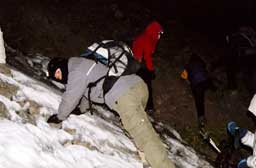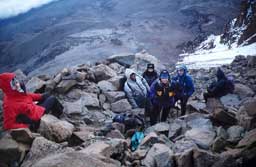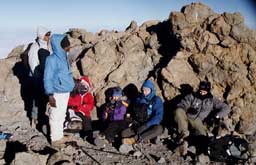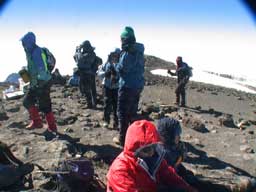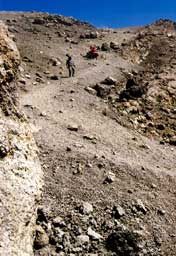Day
5 - Final Assault |
||
We kept a steady pace through the night. Our head lamps lit our way on the trail, proceeding "pole pole" rock by rock. We passed the point of no return, for there was no turning back. At times the slope was steep, but our guides chose a switchback route. Land slides appeared easy to trigger on the rocky slope, so I thought to myself that our guides could be improvising the route, but I had nothing to complain about because the route seemed sound enough. At times we scaled ice to stay on our course, at times the only course. One time I briefly slid down the ice, scampering for a grip like a cat before finally edging my boots and finding my handholds. We rested a few times in the night. Fortunately there was little wind, but the night was cold. We were well warned to wear all our clothing. I wore a T-shirt, two long-sleeved sweaters, water-resistant winter pants, hiking pants, sock liners, thick socks, a neckwarmer, a ski cap, a thin jacket, and my thick fleece jacket besides my boots, gloves, and backpack. My mistake of the night was to trust that the water in my camelback water dispenser in my backpack would not freeze; by 4 am, the coldest time of the night, I couldn't get any water through. We can be sure the air outside was well below freezing. By sunrise at 6 am, we were still over an hour from Kibo's crater rim. Apparently we were a bit behind schedule, but not beyond our cushion. As the sun rose on the opposite side of Kibo, the sky began to illuminate our path and the slope below. The appearance of the slope told us why there was no turning back. It was far too steep, too difficult to safely traverse downwards. We took some glances downhill but we knew that we could not let our minds wander under the circumstances and should keep focused on climbing up. It was best that we started at night, so we could not see that danger. At roughly 7 am we were nearing the top, crossing back and forth across switchbacks and weaving between stacks of broken rock. We were tired and dehydrated, and a little disappointed we hadn't yet reached the top. Were we going to make it to the top and back down in time? Finally, Urassa took us on one last switchback, telling us we're near the top of the crater. He took a leap across the ice and made it on the other side. After he got Darrell and the ladies across, he told me to jump. "Jump across the ice?", I asked. "Yes." And, tapping my strength, I jumped across the ice, and Urassa pulled me up. I yelped in the jump, then scampered over the ground, emerging into the blinding, piercing sunlight and reaching the crater rim of Kibo. I took off my backpack, and sat on the ground with the others. I had a headache, and I was fighting nausea, but there was something else. I felt like I was hungry, my whole body was hungry. I ate food, and Mohammed gave us pieces of chocolate. But I felt like it wasn't having any effect, as if my digestive system shut down. I wonder if my whole body ran out of energy, whether it was because of lack of food, or water, or oxygen at an internal level. But we knew we had to keep going. So we got up and walked across the crater rim. It was cold, very cold. The sun, while a bright, obvious source of energy, was powerless to overcome and warm the thin, cold air around us; the wind takes all the heat away. All the sun could do now was give us a sunburn. The crater of Kibo is rounded by a collection of jagged peaks and covered with a volcanic material that's more like gravel and powder than soil. We could see glaciers in the distance on the other side of Kibo. On the ground we walked over what at a distance looks like snow but is more like short white reverse stalactites attached to the ground. It wasn't really snow, but ice that could have been powdered then fused together. They were hard enough to hold its shape in strong wind but crushable under our feet. They were generally arranged in long, thin lines a few centimeters thick spaced a few more centimeters apart, exposing the ground like overlaid record grooves across the gravel terrain. Snow doesn't really fall here; the ice generally forms directly from the water vapor in the air, so the result is generally shaped by the winds that carry through here. The peak of Mount Kilimajaro is one of those scraggly peaks of volcanic rock jutting up from Kibo's crater rim. It is that peak, named Uhuru, that is the last 300 meters (1000 ft) we have yet to climb. After traversing the rim over the lines of crushable white ice, we scaled our way up Uhuru peak. When most developed nations pave a road these days, they usually amass mounds black asphalt gravel before crushing it into a road. The gravel that covers much of Uhuru peak is like that gravel, except it is volcanic red with reddish dust and lighter in density. Hard on the lungs, the dust we would kick up prompted us to we wear cloth or clothing over our mouths to keep in the heat and keep out the dust. Climbing up this material was slow and difficult enough. Now, combine that with the already thin air and our exhaustion and headaches and you have an experience you'll never forget. We rested just once while climbing Uhuru. This was a place that was not meant for humans to go. It was the closest thing on Earth to Mars: No water on the ground or in the air, the terrain is red, jagged, and rocky, the slopes are slippery with loose, reddish gravel, the air carried an oxygen density far below the normal level for humans, the sun shines brightly but does not heat, and the air and ground are cold and foreign. We were lucky enough that the winds were merely strong without the jet stream dipping down here as they occasionally do. We climbed over the bulk of the gravel to reach the edge of the rough top of Uhuru, but we were not quite at its highest point yet. The solid material penetrating the gravel surface was volcanic rock, gnarled and rough, full of bubbles and holes and jagged structure. Apparently it was formed by a lava flow long ago that solidified, then a later eruption must have propped this part of the lava rock up and left it there. With no water to erode the surface, the rock retains its broken, bubbled texture. I asked Urassa where the peak was, and we went where he indicated. We, all of us, made it to the top. I reached the wooden signpost first, reached in between the planks to grab the wood and bonked my head on them, just to say: I'm here. Whether it was for others to hear or to make it palpable for me, I'll never know. The winds were strong, gusty and probably 20-30 knots from the northeast, enough to blow away loose clothing and paper. The sign read a congratulation for us reaching Uhuru peak, 5895 m. There were perhaps two other parties there. All of us were tired and exhausted, barely able to move around. It was cold, windy, and we could barely breathe. And simply resting wasn't really recuperating us because just sitting there in the thin air, 45% of that at sea level, would barely supply us enough energy to survive. We sat there, exhausted, and still exhausted after just sitting there. What a way to cross the finish line. It was just after 9:15 am. But what really mattered was that we did what we set out to do, all of us. We had a view few people in the world would ever see. We were at a place few others would ever go. People who climb higher require advanced climbing equipment in places far more dangerous. We've been higher only in pressurized aircraft. We were standing on an edge of the world. We reached the Roof of Africa. We did it. After snapping pictures, giving each other hugs and comfort, and taking the moment in, it was clear to us that we could not stay long. As Urassa said earlier, the first order of business after getting to the top: go down. So we took our descent down the Mweka route. We were one of the few groups to use the Mweka route to descend. We were glad not to climb it, because it was filled with miles of the volcanic gravel we encountered on Uhuru. Climbing that is like running on sand: you spend much of your energy just pushing the coarse material around. For the descent, we often used our feet like skis, sliding down the mountain one way then the other. We'd kick up the dust, but at least we'd get down the mountain quickly. After many exhausting hours of this, we stopped in Barafu camp. I could feel the thicker air supplying me with more oxygen, which helped, but my knees and muscles were still extremely sore, and I was parched and hungry beyond what I thought I could endure. When we arrived at Barafu, we obtained water and used some mats to lie down to rest. I took the opportunity to lay down and rest. In thirty minutes, I felt so much better. I could eat, I could drink. I was sore and tired, but I could move again. But our day was not over yet. We sped our way down towards Mweka camp. The air was distinctly thicker, the small shrubs returned. We even saw fog below us, supplying moisture to our skin and suppressing dust from the air. The foliage became thicker and taller, until it formed large and sparse bushes. The fog became thick enough we couldn't see more than a few hundred meters ahead of us. On into the evening, it wasn't until 7 pm when we finally reached Mweka camp. The cooks made us a late dinner. I felt hungry, but when it came to the time, I could barely eat a morsel. The soup was wonderful, but I could barely put any of the bread or rice in my mouth. We all encountered the same problem arriving at camp: we couldn't eat. Mweka camp was like a downtown mecca compared to our previous camps. We were used to being the only campsite in view, or perhaps one other, but here at Mweka dozens of groups were all crowded together, barely enough room, crammed amongst the mud and the dirt. When I described our experience at the top to one of the other campers, I found myself slurring my speech, able to speak certain words only with conscious effort. I could only guess that I was extremely tired.
< HOME | INTRODUCTION | DAY 1 | DAY 2 | DAY 3 | DAY 4 | DAY 5 | DAY 6 > |

